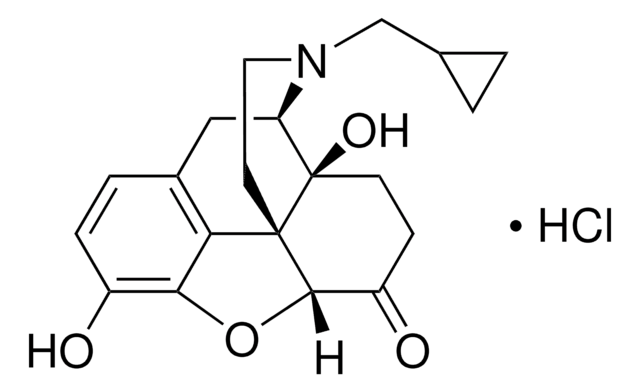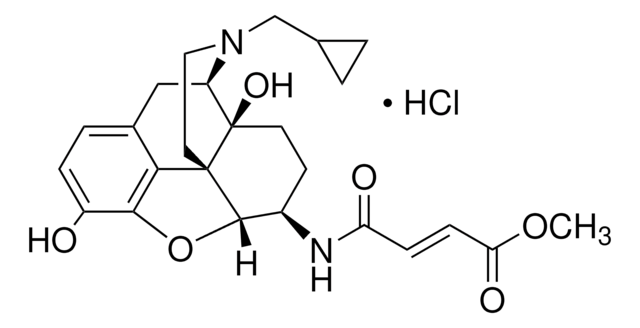B8312
BNTX maleate salt hydrate
≥98% (HPLC)
Synonim(y):
7(E)-Benzylidenenaltrexone maleate salt hydrate, BNTX-7 maleate salt hydrate, Morphinan-6-one,17-(cyclopropylmethyl)-4,5-epoxy-3,14-dihydroxy-7-(phenylmethylene)-,(5a,7E)- maleate salt hydrate
About This Item
Polecane produkty
Poziom jakości
Próba
≥98% (HPLC)
Postać
powder
warunki przechowywania
desiccated
kolor
yellow
rozpuszczalność
DMSO: >20 mg/mL
temp. przechowywania
−20°C
ciąg SMILES
O.OC(=O)\C=C/C(O)=O.Oc1ccc2C[C@H]3N(CC[C@@]45[C@@H](Oc1c24)C(=O)\C(C[C@@]35O)=C\c6ccccc6)CC7CC7
InChI
1S/C27H27NO4.C4H4O4.H2O/c29-20-9-8-18-13-21-27(31)14-19(12-16-4-2-1-3-5-16)23(30)25-26(27,22(18)24(20)32-25)10-11-28(21)15-17-6-7-17;5-3(6)1-2-4(7)8;/h1-5,8-9,12,17,21,25,29,31H,6-7,10-11,13-15H2;1-2H,(H,5,6)(H,7,8);1H2/b19-12+;2-1-;/t21-,25+,26+,27-;;/m1../s1
Klucz InChI
AGUNLJBLOJAUKM-ZKJXOIBSSA-N
Zastosowanie
Działania biochem./fizjol.
Cechy i korzyści
Hasło ostrzegawcze
Warning
Zwroty wskazujące rodzaj zagrożenia
Zwroty wskazujące środki ostrożności
Klasyfikacja zagrożeń
Aquatic Acute 1 - Eye Irrit. 2
Kod klasy składowania
11 - Combustible Solids
Klasa zagrożenia wodnego (WGK)
WGK 3
Temperatura zapłonu (°F)
Not applicable
Temperatura zapłonu (°C)
Not applicable
Środki ochrony indywidualnej
dust mask type N95 (US), Eyeshields, Gloves
Certyfikaty analizy (CoA)
Poszukaj Certyfikaty analizy (CoA), wpisując numer partii/serii produktów. Numery serii i partii można znaleźć na etykiecie produktu po słowach „seria” lub „partia”.
Masz już ten produkt?
Dokumenty związane z niedawno zakupionymi produktami zostały zamieszczone w Bibliotece dokumentów.
Klienci oglądali również te produkty
Nasz zespół naukowców ma doświadczenie we wszystkich obszarach badań, w tym w naukach przyrodniczych, materiałoznawstwie, syntezie chemicznej, chromatografii, analityce i wielu innych dziedzinach.
Skontaktuj się z zespołem ds. pomocy technicznej











